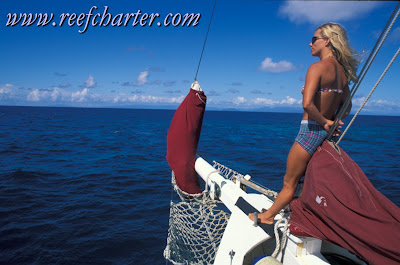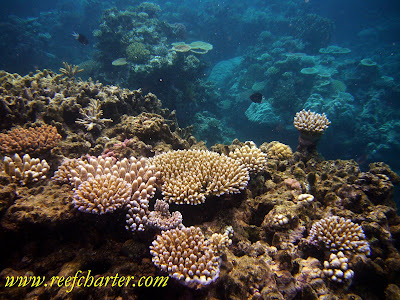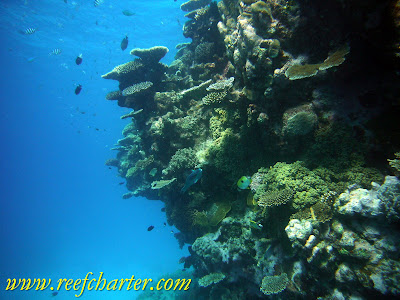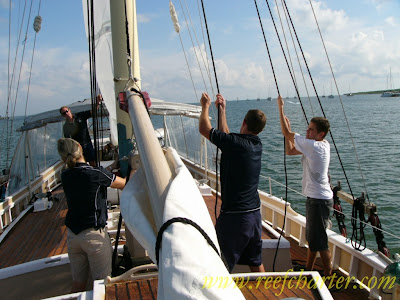With the biggest natural wonder in the world as our office and playground we lead a privileged existence. We get to experience the magnificent beauty of the Great Barrier Reef and marine life from the smallest nudibranch or shrimp to the humpback whales as they make their way north for their winter vacation. We get to scuba dive in warm water alll year round. So It can’t get much better right?
Well it can… One of the best parts of our jobs is introducing people to the wonderful ocean and the wonderous life that lives in it. Meeting people from all around the world, from the person experiencing scuba diving for the first time to the most experienced divers, sharing this natural beauty is truly a rewarding experience.
When we receive reviews and comments like this one as we often do, months after our guests have returned home it really makes our jobs even better. “The group was so happy and I spoke with tour leader and she said that literally this journey change their life!” They are planning on coming back next year as well, so the pressure is on for us to make the trip better… Thanks guys for the feedback and glad we were able to show you mother nature at it’s best.
Tag: Great Barrier Reef
How Does a Coral Reef Form?
We even have a picture with labels today, don’t get used to it. This is courtesy of Fiona please see the credits below.
A coral reef is an accumulation of the limestone skeletons of dead reef organisms and the algae that glues them together.
The coral reef builds upwards, growing towards the light much like trees in a rainforest, competing for space and light. Once the coral reef reaches sea level it cannot survive the harsh surface conditions so begins to grow outwards. Creating spectacular formations of coral that spawn further growth and spreading of the reef ecosystem.
Through time, animals grow and the sand, rubble and debris of life is broken down by waves and eroding animals, such as worms and sponges. A complex reef ecosystem is built over time. Today’s underwater gullies and caves were formed because of that erosion. These are the same formations scuba divers enjoy exploring today because they are shelters for an abundance of marine life.
Coral reefs tend to grow where there is a lot of water movement, bringing nutrients, oxygen and new species. Most reef-building corals cannot grow in waters shallow enough to expose them at high tide or deeper than 50 metres, making them highly sensitive to changing sea levels.
The Reef is continually evolving and changing as climate and sea levels change. Healthy, diverse reef ecosystems are more resilient, that is, they are able to adapt to change. The Great Barrier Reef Marine Park Authority is concentrating on maximising reef resilience through research and management.
Thanks to Fiona Merida for this great information. Fiona currently runs the Eye on the Reef Program for the Great Barrier Marine Park Authority. A very successful program that brings together and unites the Great Barrier Reef Marine Park Authority, the Great Barrier Reef tourism industry and the reef research community for the greater good of protecting the reef and educating the community.
A Brief History of the Great Barrier Reef
A lot of our readers have asked for a brief history and background on coral reef formations. I’ll try not to bore everyone. Believe me it makes a better discussion when we are sailing or diving on the reef. The Great Barrier Reef is that like every other ecosystem in world. It’s life-cycle is far greater then man’s living history and we are only just starting to understand this complex underwater world. Most research only dates back 30 years and many data points are close to shore and don’t cover the full extent, depths and variety of coral reefs.
As far as the history of the world goes, reefs appear to be a fairly new phenomenon, only one million years old, a bit older than all of us. The earliest signs of the Great Barrier Reef appeared just over 500,000 years old. Just some background here that a lot of people are unaware of, regardless of what the press etc have been reporting, seas rise and fall naturally and have been doing so since time began. During the rising phase, without human interaction, seas rise about 10m every thousand years. Over the last 500,000 years we have undergone the rise and fall of oceans just under 20 times. The current Great Barrier Reef started growing between 6 and 9,000 years ago, that is when sea levels rose over old underlying reefs and corals started growing. Sleepy yet?
So when the sea level rises the coral reefs take full advantage and often the grow faster then the sea level rises. The coral keeps growing towards the surface, like a plant towards the sun, until the reef flat is exposed at low tides (sea level). When the coral reefs reach the surface, the growth stops or slows and the battle between mother nature and the reef continues. Strong winds, storms, predators, the summer heat, as well as numerous other factors are continually impacting the reef.
So how does the reef survive this continual attack? Well, corals have evolved over thousands of years to survive this delicate ecosystem. So a couple of things:
-When coral spawns it can only successfully seed and grow if the spot it comes to rest on is clean. That means no algae or live coral. So all the damage above actually makes way for the next generation of corals.
– These cycles are natural and the Great Barrier Reef has survived these impacts for hundreds of thousands of years.
– We know from core samples taken around the world that reefs are very resilient to natural events. Only a few species have become extinct over the last 100,000 years.
– Different types of corals grow at different rates so reefs have the ability to reclaim themselves very quickly and then diversify over time as long as there is “seed” coral remaining or another reef nearby.
Coral Reefs build up slowly towards the surface, building upon the growth of previous generations as well as dead coral caused by the impacts above. This is how snorkellers and divers get to enjoy the reefs everyday around the world. By minimizing our impact on the reef we can make sure that this cycle continues.
-Follow reef safe diving and snorkeling practices.
-Reducing major pollutants that have impact on coral growth to ensure that we do not wipe out entire reef systems.
Comparing samples from older reefs to the newer reefs we see that much more damage is happening with much more frequency and to date most reefs have proven resilient. Reefs closer to major human population centres have suffered the most impact. As long as we minimize our impacts, we can be pretty sure that these amazing ecosystems will continue to inspire generations to come.
February Customer Satisfaction Results
Every month we publish our customer survey results and this month is no exception. These surveys as our guests know are compiled independently and published every month by James Cook University and aggregated from various operators every quarter. Why do we publicly expose these survey results? We think that you should have all the information available to you before making your decision on the best way to see the reef. I would also recommend that you ask other operators for their customer feedback or independent survey results before making your choice. We understand that seeing the Great Barrier Reef for many people is a lifelong dream and for many other a once in a lifetime experience, there making sure you have something to remember fondly for years to come.
Who Came on Our Trips
44% from N.America and 37.5% from Europe ,
28.5% professionals,
50% travelling with their parner,
100% first time visitors to TNQ, 94% first time reef visitors.
What They Thought
Reef met expectations: 73.3% very much & 26.7% yes
Trip met expectations: 60% very much & 40% yes
Received value for money: 94% yes
Would recommend the trip: 100% yes
Average satisfaction score: 8.88 /10




